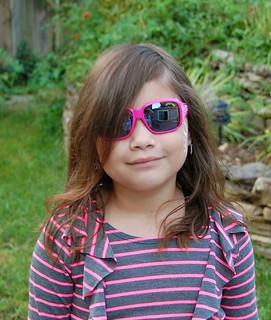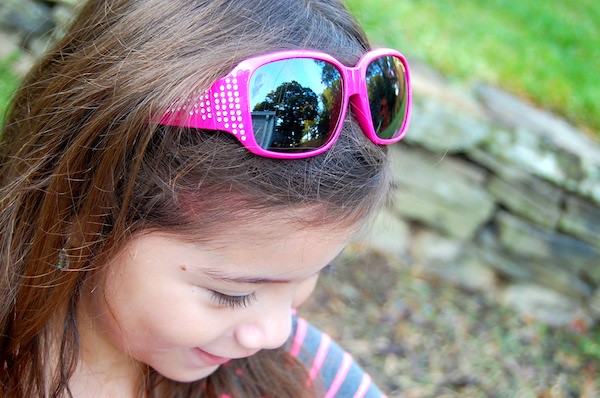Disclosure: This is a sponsored post on behalf of The Motherhood and The Vision Council.
 My daughters probably have 3 or 4 pairs of sunglasses. Each. They’re fairly inexpensive and this way we can have a pair for home and one in each car. More of a convenience factor, as the sun tends to bother their eyes sometimes. I never gave it much thought, honestly, until I participated in an eye-opening webinar presented by The Vision Council last week. While I make sure the girls always have sunglasses at their reach, I haven’t been strict about making them wear them regularly. Until now.
My daughters probably have 3 or 4 pairs of sunglasses. Each. They’re fairly inexpensive and this way we can have a pair for home and one in each car. More of a convenience factor, as the sun tends to bother their eyes sometimes. I never gave it much thought, honestly, until I participated in an eye-opening webinar presented by The Vision Council last week. While I make sure the girls always have sunglasses at their reach, I haven’t been strict about making them wear them regularly. Until now.
And I’m not the only one! Research shows that more than 40 percent of parents don’t proactively ensure their children wear UV protective sunglasses – the most effective tool for blocking damaging UVA and UVB rays. This is extremely dangerous for kids, especially those under ten, who are at higher risk of UV damage than adults. Just small amounts of intense UV exposure can cause short-term problems, ranging from irritating to overtly painful.
How do you know if your kids have been over-exposed to UV radiation? Swollen, bloodshot eyes and hyper-sensitivity to light are a few symptoms. The most extreme of these temporary problems is photokeratitis, which is sunburn of the eye. You might have heard about this from Anderson Cooper earlier this year.
You see, a child’s ocular lens cannot filter out UV rays as easily as an adult, allowing them to reach the retina. Over time, the cumulative effects of too much sunlight can lead to eye diseases and conditions later in life, such as cataracts, macular degeneration, and even cancer of the eye, all of which may result in permanent vision loss. It is never too early or too soon to protect your children’s eyes! There are important steps that you can take to shield both your kids’ eyes and your own from harmful sun exposure. It’s all about balance and protection.
• Limit outdoor time between 10 a.m. and 4 p.m. – the hours when UV radiation is strongest.
• Arm children with UVA and UVB-protective sunglasses whenever they step outside – no matter where you are, whether it’s sunny or cloudy, or what time of year it is.
• Shop at a credible source; do not purchase from street vendors, online auction sites, or second-hand stores. If possible, bring your child with you so that he or she can become a part of the experience.
• Finding sunglasses that your child feels comfortable in and likes will ensure that they are actually worn.
• Quality doesn’t necessarily translate to high cost. For children who are more apt to lose their sunglasses, consider purchasing multiple inexpensive pairs to replace lost ones.
• Polycarbonate lenses and other impact resistant lenses are more able to withstand rough play and sports.
• Darker lenses don’t necessarily mean better protection. Gray lenses absorb all colors equally and may be a good option for younger children who are still learning how to associate natural colors.
• If you don’t see a sticker or have an older pair of sunglasses, you can bring them to an eye care professional who can test them using a UV meter.
• Dressing up sunglasses can be fun but limit decorations; don’t let children draw on glasses or place stickers on the lens. This can scratch the UV protective layer.
• Hats should never be used in place of sunglasses; especially baseball caps which don’t offer peripheral protection.
• Frequent sunglass use comes with practice. Set a prime example by always wearing your own shades!

Here are some more interesting tidbits I learned from the Q&A with Dr. Adamopoulos, an optometrist and active member of The Vision Council’s Better Vision Institute:
• The difference between UVA and UVB – UVA rays account for up to 95% of UV radiation, and while less intense, they are much more prevalent than UVB rays. UVB rays are more prevalent on cloudy days and in high altitudes and are highly reflective off of snow and ice. The bottom line is that they are both damaging, so sunglasses need to protect against each.
• There are goggles with UV protection that should be easy to find in normal sports stores… but still make it a habit to have kids put on sunglasses as soon as they take a break from swimming.
• Transition lenses definitely protect eyes. The only thing transition lenses don’t do is cut down on the glare. Also, keep in mind that if glasses are too small then you aren’t protecting enough of your eye area.
• There are contacts with UV protection, however they don’t cover the entire eye. It only covers the central portion, and the white part of the eye and eyelids are still exposed.
• You can trust sunglasses with UV stickers. The ones my daughter has from the Disney store, for example. Every reputable store has to go by the American National Standard Institute regulations.
• Cataracts aren’t so much genetic- more of an age issue. If you have enough birthdays, you’re going to get cataracts. The question is how soon you want that to happen.
It’s never too early or too late to start protecting your eyes! For more resources and fun activities visit www.thevisioncouncil.org.


Liked your post. I do think that it is good to wear sunglasses everyday. Kids eyes are very sensitive it is good to make them wear sunglasses.
Weather these days are very unpredictable and the sun, when at its highest peak, is harsh and quite dangerous as it emits UV rays. I’d like to think that the simplest things with do as wearing eyewear protection can minimize the effects caused by UV rays. This article has enlisted a lot of advice to spread awareness in regards to eye protection.